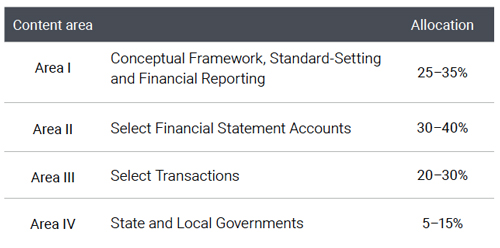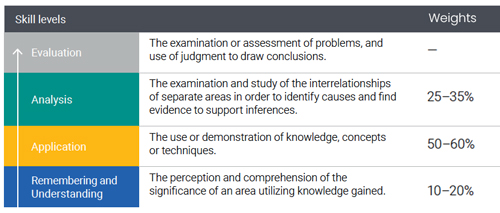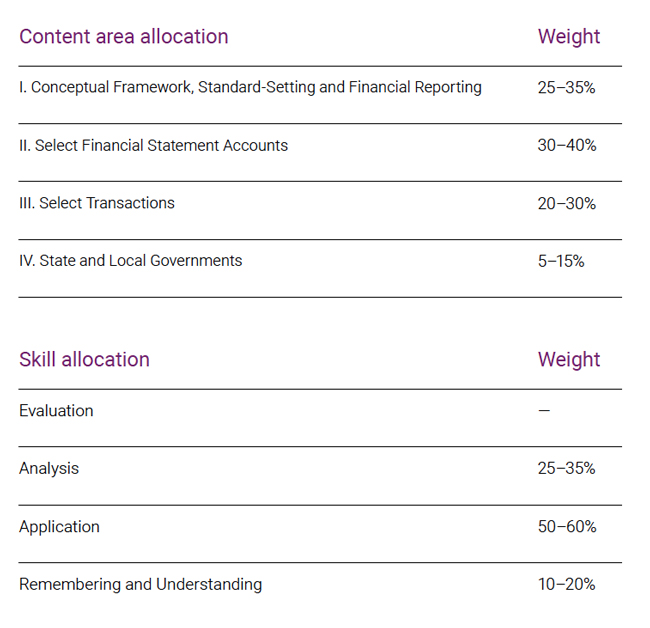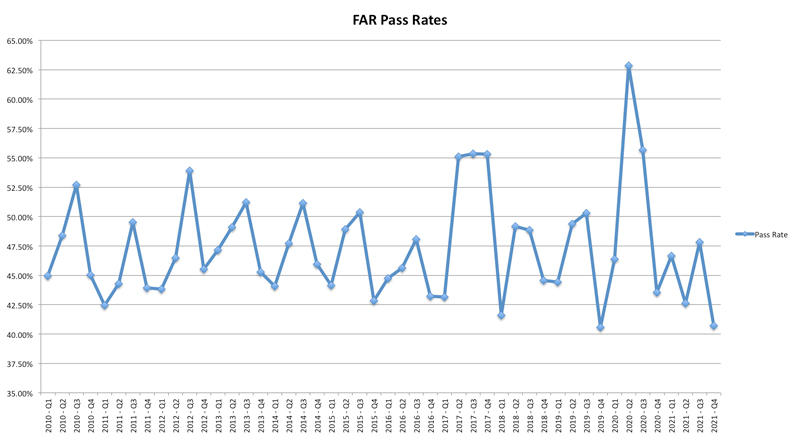What is the FAR CPA Exam Section?
 The Financial Accounting and Reporting (FAR) CPA exam section test candidates’ knowledge of GAAP and financial statement reporting for public, private, and non-profit entities. The FAR CPA exam is often considered the hardest of the four CPA sections, with an average pass rate of 45%. It is also the longest exam section.
The Financial Accounting and Reporting (FAR) CPA exam section test candidates’ knowledge of GAAP and financial statement reporting for public, private, and non-profit entities. The FAR CPA exam is often considered the hardest of the four CPA sections, with an average pass rate of 45%. It is also the longest exam section.
FAR is a difficult exam section because it covers so many different accounting topics like IFRS, GAAP, and governmental accounting. It tests your knowledge of financial reporting as well as your application skills of accounting formulas. It also covers accounting practices for employee benefit programs, investments, and company research costs.
Many candidates feel that the content covered on FAR is most similar to AUD, so they like to pair these two exam sections, but the exam topics don’t overlap that much.
Let’s analyze the FAR exam section so you can understand how it is graded, the topics are covered, when to take FAR, and how to pass the FAR exam.
How Long is the FAR Exam Duration?
The FAR exam section takes four hours to complete and consists of 2 multiple-choice testlets and 3 task-based simulations. You are allowed to take a 15-minute break after the third testlet, but you aren’t required to take a break if you don’t want to, so you could finish FAR in 4 hours.
There are no individual time limits on each testlet, so you are allowed to take as much or as little time as you need to complete each section. That’s why it’s so important to pace yourself through the exam. You don’t want to run out of time before you get through all of the testlets.
Likewise, you aren’t penalized for finished the entire exam early. You can finish the FAR CPA exam section in less than 4 hours, but if you complete all the questions before you time limit is up, it’s a good idea to use that extra time to go back and analyze the answers to questions you didn’t understand.
FAR Section Exam Topics & Materials Tested
The four main topics areas covered on the FAR exam are: Conceptual framework of Financial Accounting, Financial statement accounts, Select transitions, and state and local governments accounts.
Each of the four FAR content areas are weighted differently and covered on the exam in different amounts. Below is a complete breakdown of the topics covered on the FAR exam.
Conceptual Framework, Standard-Setting, And Financial Reporting: Accounts for between 25% and 35% of the overall exam. Some of the topics you will encounter include standard-setting processes, conceptual framework, preparation of general-purpose financial statements for profit-making and not-for-profit organizations, public company reporting requirements, special purpose framework, and financial statements for different plans of employee benefits.
State And Local Government Concepts: This is a broad area that may require a specific understanding of state and local government concepts, especially on how to prepare annual financial reports (CAFR), requirements for financial statements, and reconciliations for governments, and select events and transactions. The exam should typically have between 5% and 15% of the questions drawn from this content area.
Select Transactions: This content area entails practical application and execution of some financial transactions such as business combinations, error corrections, leases, contingencies and commitments, differences between U.S GAAP and IFRS, and software costs. About 20-30% of the questions are likely to be drawn from this content area.
Select Financial Statement Accounts: Some of the topics covered here include trade receivables, cash and cash equivalents, inventory, investments, intangible assets, long-term debts, compensation benefits, and income taxes, among others. Expect 30-40% of the questions from these areas.

The FAR CPA exams will test the candidates’ strengths and abilities. More than half the questions, about 50-60%, will touch on application, 25-35% will assess analytical skills, and 10-20% will check the ability to remember and understand accounting concepts.

FAR CPA Exam Structure & Format
The FAR exam is broken up into multiple-choice questions (MCQs) and task-based simulations (TBSs), each accounting for 50% of the overall score. There are two testlets for the MCQs, each with 33 questions, for a total of 66 questions, 12 of which are pre-test questions that are not scored. On the other hand, there are 8 TBS questions in three testlets, out of which one is pre-exam and therefore not scored.
Even though there is no specific time allocation for each testlet, it is important for candidates to be cautious with the allocated time when answering the questions. Note that the way you perform in the first testlet of MCQs will determine the complexity of the second testlet of MCQs. It is advisable not to waste time on one testlet at the expense of the other.
Below is a rundown of the FAR exam question format and structure of multiple-choice questions (MCQs) and test-based simulations.
FAR Section Exam Structure
| FAR CPA Exam Section | 2022 CPA Exam | 2021 CPA Exam |
|---|---|---|
| Multiple-choice Questions | 66 | 66 |
| Task-based Simulations | 8 | 8 |
| Written Communications | 0 | 0 |
FAR Section Exam Format
| FAR Exam Testlets | Question Types | Time / Duration |
|---|---|---|
| Testlet #1 | 33 Multiple-choice Questions | 60 minutes |
| Testlet #2 | 33 Multiple-choice Questions | 60 minutes |
| Testlet #3 | 2 Task-based Simulations | 30 minutes |
| Testlet #4 | 3 Task-based Simulations | 45 minutes |
| Testlet #5 | 3 Task-based Simulations | 45 minutes |
FAR CPA exam Study Tip: FAR is the longest CPA exam section, so you need to pace yourself. Don’t spend too much time on a single question. If you don’t know the answer, select one and move on. You can always come back to re-read the question later on. You don’t want to waste too much time on questions you don’t understand when you could be racking up correct answers to other questions.
Multiple Choice Questions
The FAR exam includes 66 multiple-choice questions split into two different testlets. Many candidates prefer the MCQs to the TBS simply because it gives them the ability to guess at possible answers. You always have a 25% chance of guessing the correct answer on an MCQ. The TBS don’t give you that option.
The first testlet will always be medium difficult questions. Depending on your performance on the first set of MCQs, your second set will either be easy, medium, or difficult. You want the difficult questions because they are worth more than the easy ones. One correctly answered difficult question might count the same as 5 correct easy questions.
Although there is no time limit to answers the multiple-choice questions on FAR, they are split into testlets. Once you complete the first testlet and move on to the second one, you are no longer able to go back and look at questions or answers in the first testlet. It remains locked. Thus, it’s a good idea to pace yourself and give yourself an hour to complete each MCQ.
The MCQ testlets make up 50% of your overall FAR score. This is down than previous years, but it is still a significant part of your score.
FAR CPA exam Study Tip: It’s important to keep moving through the MCQs. If you get stuck on a question, simply mark it and move on to the next one. Then after you make it through all of the MCQs in the testlet, go back to check the questions you’ve marked. This strategy is much faster than spending extra time on the tough questions up front.
Task-Based Simulations
The FAR exam includes 8 task-based simulations with one of them testing candidates’ research capabilities and skills. The FAR task-based simulations are often considered the hardest of any CPA exam section because they test difficult topics like pension plan calculations and footnote disclosures.
Unlike MCQs, the task-based simulations typically don’t give candidates answers to choose from. Instead of clicking A, B, C, or D, candidates are left with a blank text field to type in their answer. This, along with the difficult topics, makes TBSs much more difficult than MCQs.
Although there are only 8 TBS on FAR, you should give yourself at least 2 hours to complete them. Yes, they are that hard.
FAR Exam Testlet & Simulation Time Length/Duration
The FAR exam only allows you 4 hours to complete it. Keep in mind that none of the testlets have individual time limits, however. You are allowed to take as much time on any section that you need, but you have to make sure you budget your time accordingly, so you have enough to complete the entire exam.
How to manage your FAR test time
FAR is a long exam that covers a ton of different topics, so you want to make sure you give yourself enough time to finish each section. Spending too much time on the first sections will most likely leave you with not enough time to finish the last ones.
It’s a good idea to budget about 60 minutes for each MCQ testlet. You can spend the first 45 minutes of that going through each question. Then you can use the last 15 minutes to check your answers on the questions that you marked before you move on to the next testlet. With 33 MCQs in each testlet, that means you will have about 72 seconds to answer each question on your first run through the section.
After utilizing 2 hours to finish the MCQs, you will have 2 hours to complete the 8 FAR TBS. That means you will have about 15 minutes to answer each task-based simulation in order to complete the exam on time.
Four hours doesn’t sound like enough time to finish the entire exam, but it is if you pace yourself. If you keep an eye on the clock throughout your exam and make sure you keep up the pace, you will do fine.
How Is FAR Graded & Weighted?
The FAR exam score is weighted equally between multiple-choice questions MCQs and task-based simulations TBSs. This means that both testlet sections contribute to 50% of your overall FAR score.
One thing to keep in mind is that FAR is graded on the number of correctly answered questions without regard the questions answered incorrectly. Your score accumulates points by answering questions correctly. You aren’t penalized for incorrect answers, so it’s important to always choose an answer even if you don’t know which is correct. Don’t be afraid to guess an MCQ answer because you might get it right.
FAR also weights difficult questions more than easier questions. That means if you answer a difficult question correctly, it will count for more points than if you answered multiple easier questions correctly.
Below is the AICPA content area and skill allocations with their graded weights for the FAR exam section. This AICPA chart displays the skills and knowledge that are tested on the FAR exam and how to score higher on each content area.

MCQ & Simulation Grading Percentage Distributions
The current CPA exam weights the multiple-choice question and task-based simulation testlets equally. Thus, scoring well on MCQs is just as important as doing well on task-based simulations.
Half of your FAR score consists of 66 multiple-choice questions while the other half is scored from your performance on 8 task-based simulations.
| CPA Exam Section | Grading Score Distribution |
|---|---|
| AUD | MCQs: 50% TBSs: 50% |
| BEC | MCQs: 50% TBSs: 35% WC: 15% |
| FAR | MCQs: 50% TBSs: 50% |
| REG | MCQs: 50% TBSs: 50% |
FAR Exam Pass Rates
Here is a chart of the FAR CPA exam pass rates from 2010 to the present:

The FAR exam pass rates have decreased significantly over the past few years with a slight overall decrease in the past decade. The 2017 and 2020 scores were among the highest in the last decade with pass rates over 55%. Some CPA exam experts attribute the increase in 2020 to candidates spending more time studying at home during the lockdowns.
Since the overall high in 2020, the scores have continued to decrease ending with an all time low in Q4 of 2021.
The AICPA published that with the new changes to the CPA exam and the advent of the CPA evolution framework, they expect the downward trend of the CPA exam scores to continue in the short-term until candidates get adjusted to the new test format. This major FAR exam change is set to be implemented in 2024. The AICPA published more information about the future FAR exam changes here.
FAR CPA Exam Study Tips
It might be considered the toughest CPA section, but passing FAR does not require a miracle. With proper planning, extensive revision, research, and study strategies, you can easily pass the exam. Here are a few tips to help you pass the exam.
Take FAR Immediately After College: There are several cross-cutting content areas and topics from your previous accounting classes in college that you will come across in the FAR exam. Taking this section immediately after graduation helps you apply the college concepts because your memory is still fresh. Furthermore, this section feeds into the other three sections. This will therefore help you when you eventually take the other exams.
Use a Review Course: The exam will require a lot of applications of concepts. You must therefore practice as much as possible. Enrolling in a CPA review course will sharpen your skills, help you familiarize yourself with the examination questions, and improve your time management.
Know Where To Concentrate Your Energies: You need to know where most of the questions are drawn from. Based on previous exams, private sector, government, and not-for-profit topics account for the largest share of the questions. Concentrate here, and you might have an easier time.
Study Materials Must Be Right: You should ensure that whatever materials you are reading are right and up to date. Note that the exam content is changed regularly to capture different operational and legal dynamics.
Sharpen Your Maths Skills: Your prowess in mathematics is put to the test in this exam. It is therefore of immense importance to master excel, maths formulas, and concepts.
Should I take the FAR exam first?
FAR is an great first CPA exam section for candidates who excel in financial accounting or who have experience preparing financial statements and reports. FAR is the longest exam that covers the most topics, so it might be a good one to take right after you finish college. This way your classes are still fresh in your mind.
On the other hand, FAR is a beast of an exam. If you don’t feel confident in GAAP and IFRS reporting, it might be a good idea to save this one for a later exam. I always recommend that candidates take the exam that is the easiest for them first. This way they can get comfortable with the testing layout and not get dragged down by the hardest exam. If FAR isn’t your easiest subject, you shouldn’t take it first.
Should I take the FAR exam last?
FAR is a great last CPA exam section for candidates who have a difficult time with financial reporting. Since FAR is so massive, it can be easier to study for it after all of the other exams are out of the way. This helps you focus solely on FAR without any other distractions.
Many candidates also find it helpful to take AUD immediately before FAR. Since there is a slight overlap in topics, you will have a few concepts in your recent memory from your Auditing books.
Taking FAR last also gives you a little extra time to pass it. You might have a few different testing windows available before your first passed section expires, so you will be able to take FAR multiple times without worrying about retaking another section.
If FAR topics are challenging for you, you should probably take it last. Remember, there is no right order to take the CPA exam. It’s all about how well you know the information and how skilled you are at applying the concepts. Everyone should take the exam in their own order. If FAR is your weakest subject, you should probably take this section last.
Who Is FAR Easiest For?
Although FAR is often considered the most difficult CPA section with the lowest average pass rate, many candidates don’t have a problem acing it each testing window. Typically, the FAR section is the easiest for fresh college graduates and professionals who focus on preparing financial statements and creating financial reports.
Here are a few different candidates who tend to pass FAR quite easily:
New College Graduates: Fresh graduates of accounting or related courses are likely to come across common topics learned in previous accounting classes.
Experiences Professionals: Candidates with some experience in accounting or audit departments in the private sector, government, or non-governmental organizations.
Math Thinkers: People who enjoy crunching the numbers do well because the section is technical in nature and requires excellent analytical skills. It also includes many accounting formulas and equations that math minded candidates excel with.
Who Is FAR Hardest For?
The financial accounting and reporting CPA exam has the lowest pass rate out of any CPA exam section. That’s because it’s difficult.
The FAR exam is hardest for candidates without much financial accounting experience or financial mathematical background. It also tends to be difficult for candidates who have been out of school for a long time. Since the exam in main academic, candidates close to graduation tend to do better.
Here some candidates who struggle with the FAR exam the most.
Inexperienced Candidates: Candidates with no or limited accounting or auditing experience may find some questions too complex to answer accurately unless they have widely read and practiced.
Candidates Out of School: Candidates who have not been in an accounting class for an awfully long time. Therefore, it is recommended for fresh candidates to proceed with FAR as soon as possible when their memories are still fresh.
Non-Math Thinkers: If you are poor in mathematics, then this is likely to require extra work to pass it. The section requires a lot of calculations and the use of formulas.
Poor Preparation: Poor preparation is also a major contributor. You should read beyond the material recommended and provided by the AICPA.
Other CPA Exam Sections
- AUD CPA exam section
- BEC CPA exam section
- FAR CPA exam section
- REG CPA exam section
- Breakdown of all 4 CPA exam parts
What’s the best CPA study course for FAR?
The best CPA exam study aid for FAR depends on your learning style. Everyone learns differently and each of the main courses tend to focus on different types of learners. The important thing is that you find one that fits the way learn best.
You should be able to know which formulas to apply, detect potential risks and advise management through accurate financial reporting. The FAR section might be dreaded by most candidates, but it is possible to ace it on your first attempt if you plan appropriately and study extensively.
Get the right course and you should have no problem acing FAR on your first attempt!

